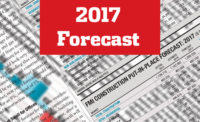No more federal stimulus money, no highway bill, a weak economic recovery, a stalled housing market, a nonresidential building market yet to bottom out, gridlock in government, continued high unemployment—it could add up to no inflation in 2011. That is about as simple as a cost forecast can be. Inflation? Not so much. Engineering News-Record expects its Building Cost Index to increase just 1.3% next year after rising 3.6% in a difficult 2010 market. ENR projects its Construction Cost Index to increase 2.0% in 2011 following this year’s 3.6% gain.
The accuracy of ENR’s forecast is heavily influenced by union wage settlements, which account for 80% of the CCI and 65% of the BCI. With the economy still limping along and construction starts in a slump, there is little confidence that labor wages and benefits could improve significantly in 2011. Union settlements through 2011 will see an average increase of 3%, according to the Construction Labor Research Council, Washington, D.C. Bob Gasperow, president of the CLRC, notes that some of those increases were settled three years ago, before the economic downturn. “Those settlements [from three years ago] are still working through the system,” he says.
In light of the downturn, Gasperow notes that short-term deals have been common. “So many one-year deals were negotiated in 2010 that 2011 will be a heavy bargaining year,” he adds. Those agreements will be negotiated under the cloud of historically high unemployment, which in November was still stuck at 18.8% for construction, according to the Bureau of Labor Statistics.
Denise Gold, associate general counsel for labor and employment law for the Associated General Contractors of America, says many AGC members expect that 2011 settlements will remain consistent with 2010 levels. A year ago, ENR predicted that the skilled labor component of the BCI would increase 3.0%; it ended the year with a 3.3% gain. The labor component of the CCI was projected to increase 3.3% this year but ended 2010 with a 3.5% gain.
Next year, ENR believes wage settlements will be hard-pressed to match the 3.0% increase already agreed to in multi-year contracts. ENR’s forecast is for the labor component of the BCI to increase 3.0% next year, while the CCI’s labor component is expected at 2.9%.
The materials component of ENR’s cost indexes is expected to see little inflationary pressure next year. The most common themes voiced by economist interviewed by ENR were that prices were “bottoming out, flat or trending sideways.” In ENR’s forecast, that translates to a 2.1% decline in the MCI, which increased 4.3% this year.
The Portland Cement Association, Skokie, Ill., forecast that cement consumption in 2011 will inch up just 1.4%, following a 27% decline in 2009 and a mere 0.3% gain this year. That will not be enough to budge prices. The forecasting firm IHS Global Insight, Washington., D.C., predicts that cement prices will increase just 0.3% next year after falling the previous three years. Overall, ENR’s forecast calls for a 0.5% decline in cement prices.
Lumber prices, which experienced some volatile swings this year, are expected to be relatively calm in 2011. The composite lumber price tracked by the Bedford, Mass.-based forecasting firm RISI peaked last April at $357 per thousand board ft, which was up 85% from the previous year. By this month, that price was back down to $263. “After some seasonal movement we expect prices to end next year at $260,” says Robert Berg, an RISI economist. “The industry is operating at 60% capacity, and that won’t get above 70% next year,” he says. “It’s hard to sustain price increases in that environment.” ENR’s forecast calls for lumber prices to decline 1.5% next year.
Steel prices will also trend sideways in 2011, says John Anton, analyst for Global Insight. He says scrap prices are very high right now. “Demand is so bad that scrap prices should come down and with it prices for structural steel.” He says prices have already fallen from a peak of $736 a ton last summer and expects prices to hit $664 a ton by the fourth quarter of next year. ENR’s forecast calls for 2.5% decline in steel prices.



Post a comment to this article
Report Abusive Comment